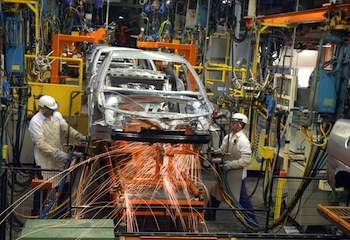The director of GM's São Caetano do Sul Plant, in São Paulo, talks about updating the 84-year-old facility to keep pace with the demands of modern production
Joanne Perry (JP): How important is the São Caetano do Sul Plant as a production location for GM in Brazil?
Sonia Campos (SC): São Caetano do Sul as a production location is very important for GM. In this plant we produce four car models – the Cruze Sedan and Sport, Cobalt and Spin – and the Montana pick-up in a complex which has bodyshop, paintshop, general assembly and fabrication areas, such as: press shop, sub-assembly and plastic injection/paint plant. Besides that, we have: a tool and die shop, the GM Brazil headquarters, Product Engineering, Manufacturing Engineering, Design, Global Purchasing and Supply Chain, among other departments.
JP: This plant recently underwent a redevelopment, including the installation of automated presses. How did you minimise disruption to the production?
SC: We have global guidelines to guarantee a safe and flawless launch. The new press lines are state-of-the art technology and provide a reliable output, avoiding disruptions in production due to a lack of parts. On top of that, these high-tech press lines allow us to improve the surface quality of the panels on our products. We were recognised last year for achieving a high level of production quality, receiving the BIQ level III certificate.
JP: What do the new presses deliver in terms of efficiency and output?
SC: The output is 30% higher than the old presses, set-up time is 50% less and there has been an impressive improvement in quality due to the new technology. These presses also comply with the new Brazilian safety regulation, NR12.
JP: Is the redevelopment complete or do you still have work to do?
SC: For sure, we have a lot to do. This process of continuous improvement requires a 'never-ending' mindset. In the last few years, we have implemented technologies to drive us to a highly competitive stage. We did that in the bodyshop with a new project in 2011-2012, when we launched four different models. With these new press lines that we are installing, we are meeting government requirements and optimising the process and labour.

SC: The new MASC warehouse will be able to absorb 100% of the material inside the plant for new projects, meaning less dependency on third-party warehouses.
Besides that, the latest lean material strategy in the warehouse maximises all internal areas, with new concepts for the shelves, industrial vehicles and receiving area. It will allow São Caetano do Sul Plant to improve material handling efficiency as well as contributing to reduced logistical costs.
JP: Has the redevelopment involved the implementation of any sustainability projects?
SC: GM Brazil is committed to sustainability and is pioneering several environmental practices at its new engine plant in Joinville, southern Brazil. Joinville is the first [GM] facility to introduce a water recycling process using reverse osmosis, it has the first solar energy system in the Brazilian automotive industry and it is also the first to employ a new way of treating sewage and wastewater by a wetland process. These sustainable features have seen the plant gain Leadership in Energy and Environmental Design (LEED) certification from the US Green Building Council.
"We will never be like Joinville, but we have a lot of initiatives to improve water recycling, energy use and waste elimination"
– Sonia Campos, GM São Caetano do Sul
JP: Do you have any sustainability projects specifically at São Caetano do Sul?
SC: For this plant here we have some initiatives but we cannot share them yet because so far we haven’t approved the investment. We will never be like Joinville, because we are 84 years old! But we have a lot of initiatives to improve the water recycling, energy [use] and waste elimination – focusing on landfill-free status. We are in an ongoing investment approval phase.
JP: Considering how old it is, do you think there will ever come a time when this plant closes and operations transfer to newer facilities like Joinville?
SC: I don’t see that happening, because every year we implement new projects here. For example, the masking area; we built a new warehouse with a completely new sustainability concept. So the light is from outside, the height of the building [allows natural ventilation]. That’s the reason that I see GM continuing to operate this plant.
We are also well located, close to the dealers, customers, suppliers and port. We are integrated into the city and the city is integrated into us; most of the community work for us here. They are here because we are here. This plant is very important for the community.
JP: How likely is it that São Caetano do Sul will its increase its capacity in the near future?
SC: GM São Caetano do Sul is one of the most complex plants in the organisation and it is working close to maximum capacity in three shifts, more than 40 hours per week, and producing all planned models. Increasing the capacity in the plant would depend on many variables, such as market demand, the strategy of the company, and new projects/models to be assembled in this plant and others.

SC: The challenges to vehicle manufactures in South America are similar to all global regions. It is important to continue focusing on a diverse portfolio of products and technologies to meet the needs of the most discerning customer, to accelerate innovation and to achieve and sustain competitive differentiation based on business opportunities and strategy.
JP: What improvements would you like to see most, for example in terms of logistics, the supply base, skilled labour?
SC: The expectation is that South America will improve in those areas by continuing to move along the path that was initiated a few years ago. Just like any automaker, the continuous improvement mindset is crucial to survive in this market. We have worked with the suppliers for a long time and I would say that we don’t have huge problems in the supplier environment here. If you look at the number of automakers that are coming to work here, you can see we are developing the suppliers.
JP: Can you say who was the supplier that was on strike earlier this week [May 20-22], causing the plant’s presses to stop for three days?
SC: They produce subframes, axles. They have some internal problems and are discussing salaries and other compensation, so the employees were on strike. But this problem is no different from Europe. When I worked there [as plant director at Eisenach, Germany] I experienced it then as well; suppliers in Spain that were on strike.
JP: And what about your own labour force; can you find people with the skills that you need for this operation?
SC: Yes. We have here in GM São Caetano a kind of co-operation with the union, what we call focus projects. With the focus projects we work to develop specialists, for instance in mechatronics. We develop training for the people in the community and at the end, when we have an open position here, we bring them in to work. So this kind of co-operation helps a lot when we need some specialist development.

JP: Finally, how does the Brazilian Government’s Inovar-Auto programme affect operations at the plant?
SC: It affects our strategy for researching the increased energy efficiency of our vehicles, such as aerodynamics, fuel economy, mass and new technologies working towards this target. These new developments begin in design and product engineering, go through experimental development and finally come to manufacturing and product validation. GM Brazil has always had a strong focus on new technologies and products that are cutting-edge. The Inovar-Auto programme focuses on investments and the local development of new technologies; GM Brazil continues working to achieve increased levels of energy efficiency set by that programme.






































